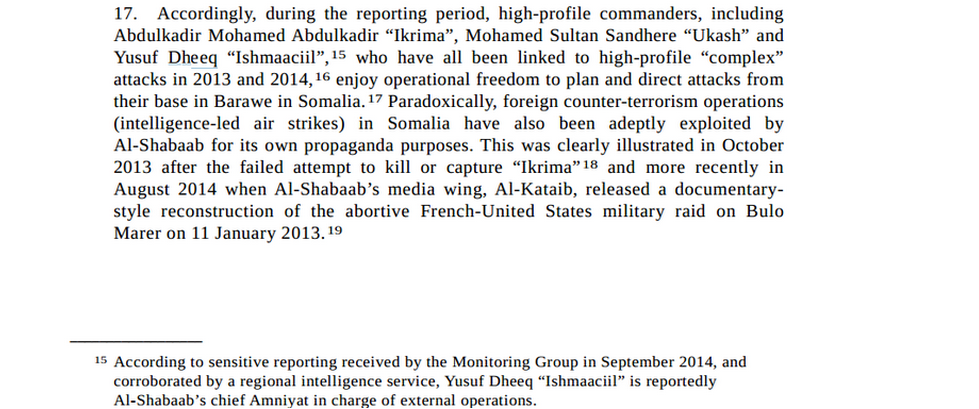Summary
- Al-Shabaab’s most recent propaganda video is intended that its fighters aren’t “in fear or hunger,” but loss of territory and increasingly successful drone strikes show continued vulnerabilities.
- Air strikes against top al-Shabaab leaders are of limited benefit if not coupled with successful ground operations and political progress — which continue to both stall.
According to al-Shabab official media outlet Radio Andalus, the group’s new video is intended to show “no fear or hunger” on the ground for its forces on the front lines in Lower Shabelle.
The video shows the militants swimming in the river, calmly preparing meals, and listening to religious lectures in woody camps. It also shows them attacking AMISOM convoys from covered positions in the brush.
These images seek to paint the picture that the militants are not under pressure to defect as claimed by ex-fighters and as often portrayed in the media.
Several fighters in the film offer high praise about their exploits. Without a doubt, the group feels that better advertising for recruitment is needed. Syria and Iraq have trumped Somalia as the destination of choice for jihadists in the last few years after al-Shabaab became known as much for infighting as for high-profile attacks.
Life Under a Drone
Though al-Shabaab’s film boasts about the relative freedom, relaxation, and “adventure” that these fighters enjoy, drone attacks continue to successfully target the group’s top leaders.
Since September 2014, the group’s chief Ahmed Abdi Godane and Amniyaat leader Tahlil Abdishakur have been killed in targeted air strikes.
This week, another United States drone attack in Dinsoor (Bay region) reportedly killed al-Shabaab’s chief of external operations, Yusuf Dheeq. In a 2014 UN Somalia and Eritrea Monitoring Group report, Dheeq was identified as one of the main planners of complex attacks, along with his counterpart and Westgate raid architect Abdulkadir Mohamed Abdulkadir “Ikrima.”

It is important to note that there is currently no active offensive by AMISOM and Somali forces to capitalize off of these successful drone strikes.
There are many different reasons why observers believe there is no sustained ground operation at the moment, including the following:
- Political instability at the top: Continued political crises between the President and Prime Minister and disagreement over composition of the PM’s cabinet disrupt progress in the security sector and other areas;
- Difficulty in post-liberation administration: Potential corruption in at least one caretaker administration that was trained by the international community;
- Foreign Interests: Alleged desire by AMISOM commanders and troops to sustain presence in Somalia for political/monetary/strategic reasons; others believe disagreement over coordinating an offensive between all contributing countries and the Somali government plays a role.
As has been seen in Syria and Iraq, the use of drones to kill high-level targets cannot tip the scale on the battlefield unless these strikes are coupled with effective ground operations from a military perspective. This combination is important in Somalia for several reasons.
Keeping Al-Shabaab Officials On the Move
Since al-Shabaab has lost major safe havens like Kismayo and Barawe in the last two years, this has meant that the group’s top officials may have had to become more mobile. This has offered opportunities for the U.S. and other allies of the Somali government to perhaps gather more consistent intelligence on al-Shabaab leaders’ movements and successfully target them with Hellfire missiles. Raids by special forces are more risky and have been less successful.
When ex-leader Godane was killed in a U.S. drone strike in September 2014, there was a unique opportunity to make a huge military push against the group and make it more difficult for his successor Ahmed Umar Abu Ubaidah to ensure a seamless transition in power.
Instead, plans for renewed operations continued to stall, and al-Shabaab will be allowed to recuperate more easily by naming new senior leaders who will have more time to adjust to their new roles and plan “retaliatory” attacks — such as AMISOM base raid in Mogadishu on Christmas Day 2014.
No Rain, No Gain
In the past, AMISOM has been wary of carrying out an offensive during Somalia’s rainy season, and the long and often intense Gu rains from March to June are rapidly approaching.
Therefore, it may not be until July 2015 when AMISOM and Somalis embark on a new offensive against al-Shabaab, which still controls Middle Jubba region and other areas and often blockades aid from reaching government-controlled towns.
These challenges will add even more obstacles to Somalia’s efforts to create coherent regional administrations that are able to govern and deliver services within their borders.
Categories: al-Shabaab

 Kenyan Troops “Hid in the Grass” During Al-Shabaab’s Airstrip Attack at U.S. Base
Kenyan Troops “Hid in the Grass” During Al-Shabaab’s Airstrip Attack at U.S. Base  Weekend Note: Al-Shabaab and Kenya’s Tit-for-Tat Destruction of Telecom Infrastructure
Weekend Note: Al-Shabaab and Kenya’s Tit-for-Tat Destruction of Telecom Infrastructure  Key Updates to Al-Shabaab’s Attack on U.S. and Kenyan Forces
Key Updates to Al-Shabaab’s Attack on U.S. and Kenyan Forces  PHOTOS: Al-Shabaab Damage Equipment During U.S. Base Attack in Kenya
PHOTOS: Al-Shabaab Damage Equipment During U.S. Base Attack in Kenya
The Amisom forces would perfectly flush out Al Shabaab takfiris if drone attacks were coordinated with their offensive.Thanks to them anyway,Al Shabaab is weak and cornered.